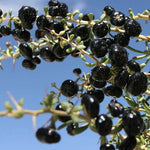Subscribe and save 10%!

Black Goji Berry / Black Wolfberry (Lycium ruthenicum)
36 SEK
Unit price perExpected delivery date: 19 December to 26 December.
Applies to orders within Sweden. For other countries - see our delivery terms .
In stock - Ready to be shipped
Share
36 SEK
Unit price perSEEDS (20pcs/bag)
Common name: Black Goji Berry, Black Wolfberry, Russian Boxthorn, Siyah Goji, Kaokee
Scientific name: Lycium ruthenicum Murr.
Family: Solanaceae
Plant history & use:
Black Goji is, like its relative Goji (Lycium barbarum), a rich source of proteins and vitamins. The black goji berry is particularly rich in anthocyanins, with a content higher than that of blueberries. The shrub originates from the areas around the Tibetan Plateau and southern Russia.
Black Goji is a plant that has not yet received much attention in the West, but it has long been used by the indigenous people in the regions of its natural environment. Surprisingly, the indigenous people of small North Indian communities use the berry to make an ointment to prevent blindness in camels. This is possible thanks to the berry's high content of lutein.
The berry gets its deep blue/purple color from the anthocyanins, a substance found in unusually high concentrations in the Black Goji Berry. Anthocyanins are the same substances that give blueberries their blue color and also contribute to a large part of their nutritional value.
Ripe Black Goji berries can be eaten raw, dried or cooked.
The most common way to consume black goji berries is to make a so-called infusion. This is best done when they are completely fresh, but it can also be done with dried berries. The goji berry gives off different colors depending on the type of water used. In mineral-rich water (basic: pH >7) the infusion becomes deep blue and in acidic water (pH <7) the color sets to an intense purple.
Cultivation:
Black Goji natively grows in fairly extreme climates where it is exposed to drought, extreme cold, high salinity and nutrient poor soils. These factors have made the Black Goji berry a very hardy plant. It can thrive in temperatures down to -20 ºC.
The Black Goji is an easy-to-grow shrub that often produces rich harvests. It likes to grow in well-drained soils (often sandy soils) and establishes a strong root system, which makes it a good soil binder, e.g. at beach sides to prevent erosion as well as shelter from coastal winds. It thrives in locations with lots of sunlight.
The Black Goji bush grows up to 2 m and can be grown outdoors in open ground in all of Europe. To protect the Black Goji bush from the harshest conditions, you can cover the base of the plant with straw, leaves etc. in late summer and keep it covered during the colder months - this will protect the plant from the most severe cold as well as prolong the growing season.
The numerous berries first appear in green to later turn black/bluish-purple. It is only then that they are ready for harvest. This takes place in summer-autumn.
Sowing:
The seeds are sown in moist soil. Cover with a thin layer of soil. Keep the seed moist.
Characteristics:
Lifespan: Perennial
Location: Sun
Height: 1-2 m
Germination Time: 1-3 weeks
USDA Zone: 5-9
- Choosing a selection results in a full page refresh.
- Opens in a new window.









